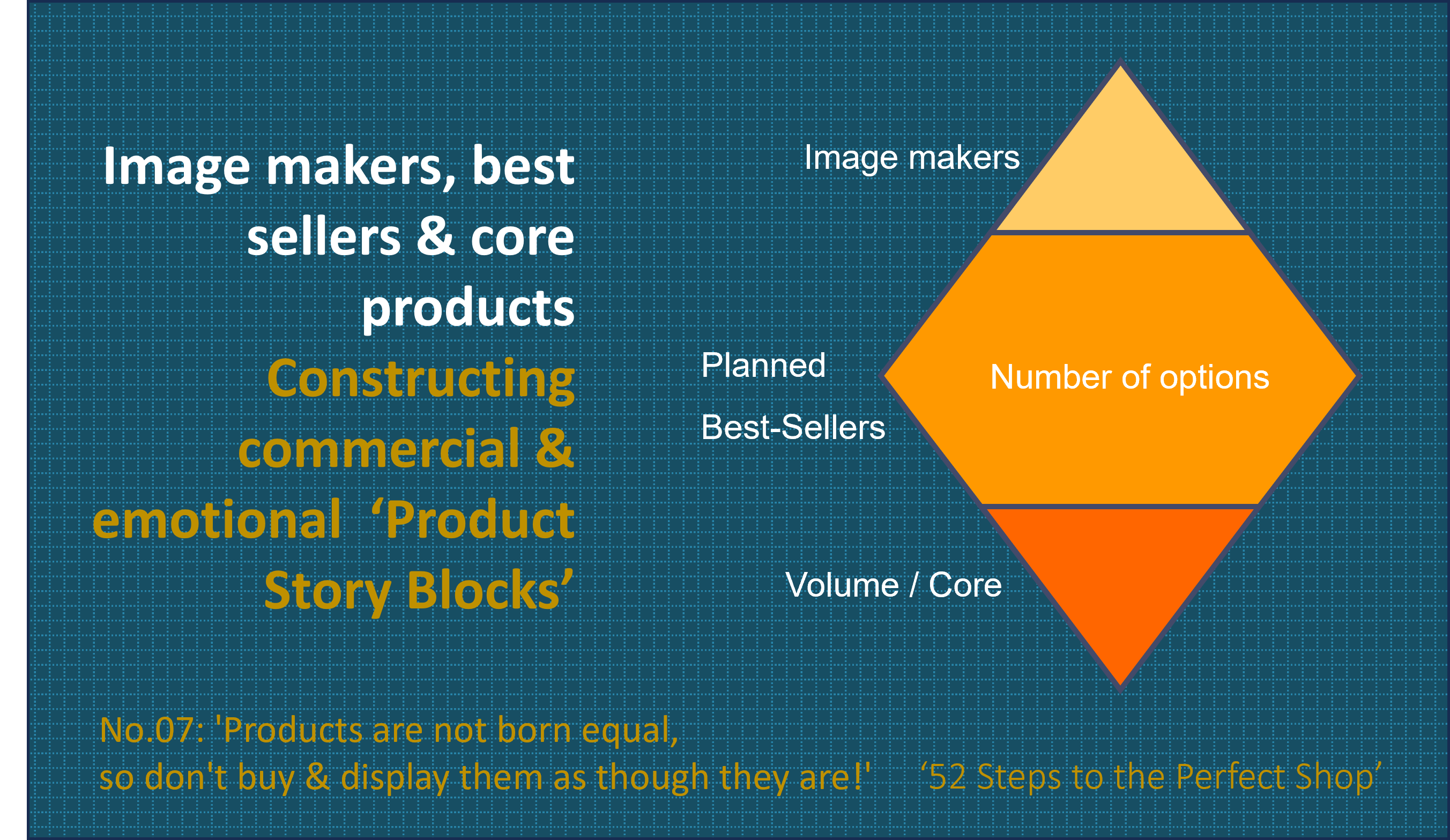Post No.07 in the weekly newsletter series:
‘52 Steps to the Perfect Shop!’
You too can have ‘The Perfect Shop’ by this time next year!
‘Products are not born equal!’ They have different commercial and emotional roles to play in your assortment.
And to be financially successful, you need to have the correct balance of these different types of products, and you need to mix and distribute them appropriately in your shop.
In terms of ‘product story blocks’ you must always consider the commercial & emotional purpose of each block and construct them with the appropriate product type mix.
Whilst it’s true to say that every product has its own story, in terms of their core role within the assortment, and product blocks, there are 3 different types you must consider.
These form the commercial diamond of image makers, planned best sellers and core products. Each with a vital role to play.
Image makers are highly visual products. They mostly catch the current trends, but may also be showing the newest product designs or technologies of a brand. In either case they must be highly visible within a shop, and within product story blocks.
The thing about image makers is that they generally wont be what you sell the most of. Visually and design-wise they may be too ‘out-there’ for most customers. In addition, because most time and energy generally goes into these products they will either be at the expensive end of your assortment, or will have smaller profit margins.
Use image makers to attract attention and pull customers to your ‘product story blocks’ but they won’t make your fortune so don’t have too many.
Core products, often called volume products, are the opposite in many ways to image makers. They are not the most visually outstanding but you will sell a lot, continuously, and the profit margin will be high.
Core products are what you know customers always buy. They have wide appeal. People wear them as staple products from their wardrobes. In your shops avoid the temptation to put them everywhere (to drive sales) because if you do your shop will look dull and monotonous. And will be empty.
Include core product sparingly within mixed ‘product story blocks’ to add easy sales and margins, but also create ‘product story blocks that are totally constructed of core products. Just don’t use these to make your shops existing or dynamic.
Finally, we come to the ‘planned best seller.’ Most products should fall into this group. This is where you will make profit. they have good sell-through, good margins and will sell well for a season.
The key to designing & buying ‘planned best-sellers’ is to understand what your customer already likes about your designs, and to cleverly adapt and update those attributes so they reflect the latest trends and customer buying patterns.
These will appeal to customers who want to be current, but not necessarily on-trend, who want to wear for a longer-time but not the same-old thing.
Interestingly whether you’re selling new, second-hand or pre-loved these rules still apply, although image may also represent rarity. Your problem may be in sourcing enough core or bestseller product because customers tend to hold on to these themselves.
‘Products are not born equal!’ In your buying & your sourcing you need to understand and incorporate the commercial and emotional attributes of these 3 types of product.
Then, in your total assortment, and in particular how you coordinate them within ‘product story blocks’ and as ‘product story blocks’ you need to find the balance that attracts customers, and encourages them to buy your most profitable products.
Going back to my fundamental point. If you are still planning and buying by individual product, or small uncoordinated groupings, without considering how they will all look together visually as ‘product story blocks’ in the shop, then you are putting yourself at a huge disadvantage, to make your shops look good, and your shop sell well!
But even if you are buying in ‘product story blocks’ your displays may look fantastic but they still might not be generating the sales, margins and profits that you need.
‘Product story blocks’ are layered with assortment strategies. This does make buying & visual merchandising more complex, but the rewards for following some basic commercial rules are well worth the effort!
’52 Steps to the Perfect Shop!’
For everyone looking to improve their physical shops, or thinking of opening their first pop-up or permanent shop.
The weekly newsletters, and the 10 content modules they feature, have been created from my experiences of opening hundreds of shops, of all different sizes, situated across the world, selling just about everything there is to sell.
Every week we explore the sequential process of physical shop development to help you deliver your perfect shop.
Missed any of the previous ’52 Steps’ then just click here to catch up…
